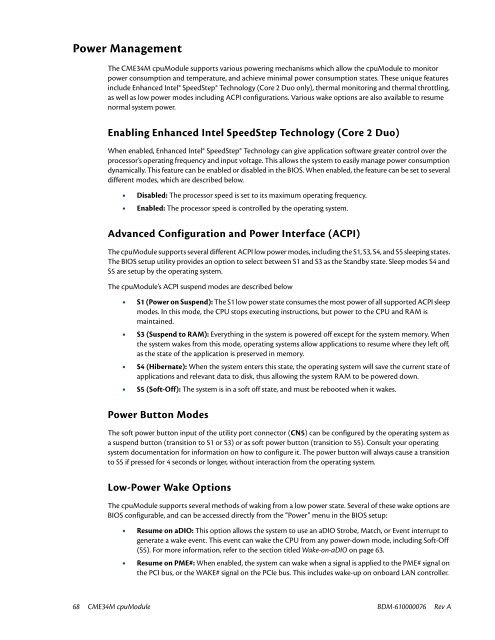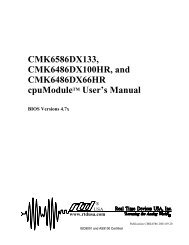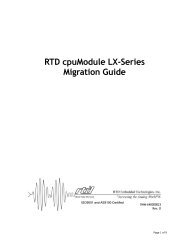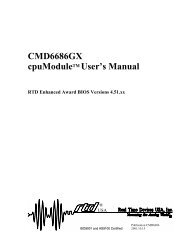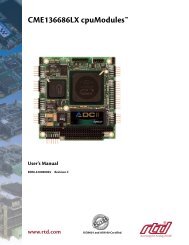CME34M Hardware Manual - RTD Embedded Technologies, Inc.
CME34M Hardware Manual - RTD Embedded Technologies, Inc.
CME34M Hardware Manual - RTD Embedded Technologies, Inc.
You also want an ePaper? Increase the reach of your titles
YUMPU automatically turns print PDFs into web optimized ePapers that Google loves.
Power Management<br />
The <strong>CME34M</strong> cpuModule supports various powering mechanisms which allow the cpuModule to monitor<br />
power consumption and temperature, and achieve minimal power consumption states. These unique features<br />
include Enhanced Intel® SpeedStep® Technology (Core 2 Duo only), thermal monitoring and thermal throttling,<br />
as well as low power modes including ACPI configurations. Various wake options are also available to resume<br />
normal system power.<br />
Enabling Enhanced Intel SpeedStep Technology (Core 2 Duo)<br />
When enabled, Enhanced Intel® SpeedStep® Technology can give application software greater control over the<br />
processor’s operating frequency and input voltage. This allows the system to easily manage power consumption<br />
dynamically. This feature can be enabled or disabled in the BIOS. When enabled, the feature can be set to several<br />
different modes, which are described below.<br />
• Disabled: The processor speed is set to its maximum operating frequency.<br />
• Enabled: The processor speed is controlled by the operating system.<br />
Advanced Configuration and Power Interface (ACPI)<br />
The cpuModule supports several different ACPI low power modes, including the S1, S3, S4, and S5 sleeping states.<br />
The BIOS setup utility provides an option to select between S1 and S3 as the Standby state. Sleep modes S4 and<br />
S5 are setup by the operating system.<br />
The cpuModule’s ACPI suspend modes are described below<br />
• S1 (Power on Suspend): The S1 low power state consumes the most power of all supported ACPI sleep<br />
modes. In this mode, the CPU stops executing instructions, but power to the CPU and RAM is<br />
maintained.<br />
• S3 (Suspend to RAM): Everything in the system is powered off except for the system memory. When<br />
the system wakes from this mode, operating systems allow applications to resume where they left off,<br />
as the state of the application is preserved in memory.<br />
• S4 (Hibernate): When the system enters this state, the operating system will save the current state of<br />
applications and relevant data to disk, thus allowing the system RAM to be powered down.<br />
• S5 (Soft-Off): The system is in a soft off state, and must be rebooted when it wakes.<br />
Power Button Modes<br />
The soft power button input of the utility port connector (CN5) can be configured by the operating system as<br />
a suspend button (transition to S1 or S3) or as soft power button (transition to S5). Consult your operating<br />
system documentation for information on how to configure it. The power button will always cause a transition<br />
to S5 if pressed for 4 seconds or longer, without interaction from the operating system.<br />
Low-Power Wake Options<br />
The cpuModule supports several methods of waking from a low power state. Several of these wake options are<br />
BIOS configurable, and can be accessed directly from the “Power” menu in the BIOS setup:<br />
• Resume on aDIO: This option allows the system to use an aDIO Strobe, Match, or Event interrupt to<br />
generate a wake event. This event can wake the CPU from any power-down mode, including Soft-Off<br />
(S5). For more information, refer to the section titled Wake-on-aDIO on page 63.<br />
• Resume on PME#: When enabled, the system can wake when a signal is applied to the PME# signal on<br />
the PCI bus, or the WAKE# signal on the PCIe bus. This includes wake-up on onboard LAN controller.<br />
68 <strong>CME34M</strong> cpuModule BDM-610000076 Rev A


